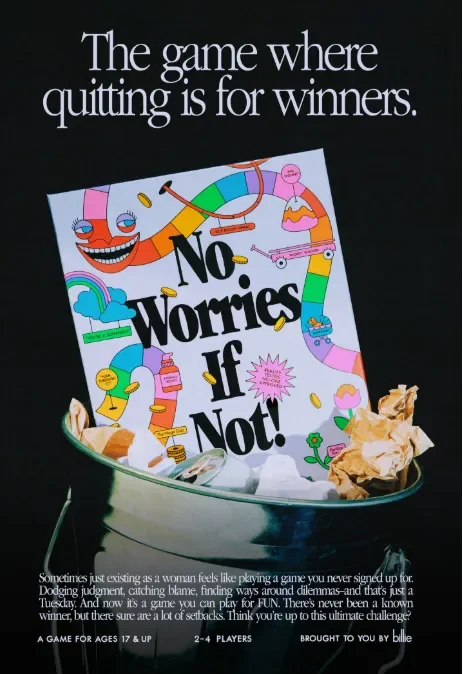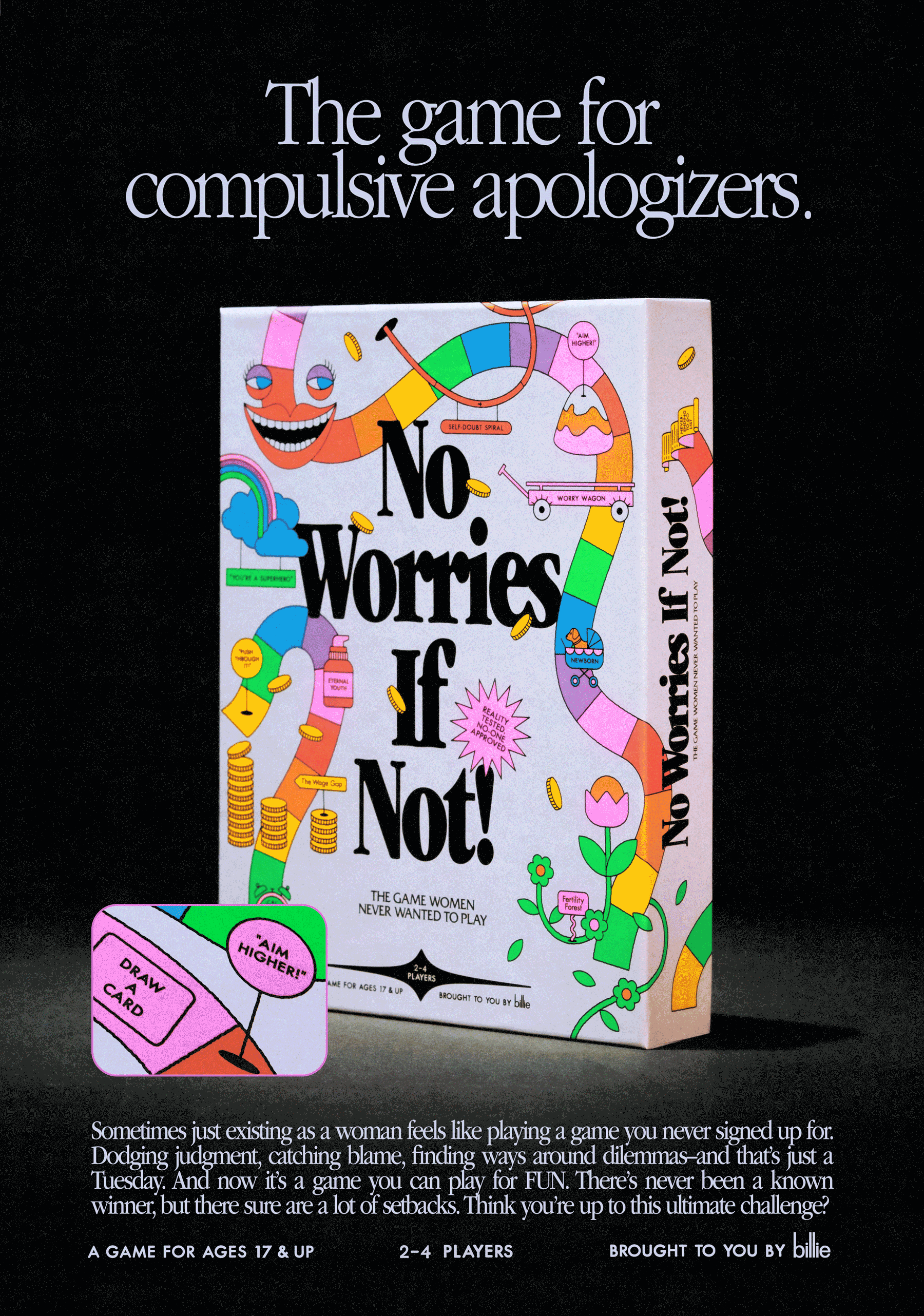When You're a Razor Brand, Body Hair is Not the Enemy
In 2023, I used real American dollars to purchase a board game published by a disposable razor company. The game sits on a shelf in my office and I look at it often, although I’ve never had a group of people sit around and play it. Still, I assure you that the components were produced with quality and that it is chock full of thoughtful details. The board game is called “No Worries If Not!” and I purchased it from Billie’s website. While I was there, I threw in some soaps, lip gloss, and shaving cream. For this audience of one, it was a very, very effective piece of brand marketing.
So, I was delighted when I opened my inbox this week and saw an email from Billie announcing their new Chia Pet. “Meet the Billie Chia Pet! Experience the new way to grow out your armit hair as long and as bushy as you want!” There’s even a retro 90s-style commercial with the same catchy jingle.
For $25.99 plus tax, I will receive my very own Billie Chia “Pit.” The shipping is free and as an extra bonus I’ll get “Free will to grow out your armpit hair as long and fuzzy as you’d like.” Sold!
I’m a fan — not necessarily of As Seen on TV fads that will end up at a White Elephant party, but of Billie pulling off this magic trick. The personal care brand has once again turned their brand mission into a piece of culture; one that will not only sell out but that will surely start some conversations when it starts showing up in the background on Zoom calls.
What to do with your Brand Values?
In today’s highly polarized culture, it’s more important than ever to have clarity about your mission, values, and what you stand for. Even as prices inflate and economic uncertainty looms, consumers want to know if, say, the money they spend with your company is going to pay the salary of a deranged, anti-DEI conspiracy theorist/consultant. (WTF, Meta?) But once they’ve checked the box on brand values, big companies don’t know what to do with them. They either figure that taking a stand is not worth a potential hit to the bottom line, or they pay lip service to the mission in a way that gives consumers the ick.
Yet somehow, Billie keeps breaking through. Their Chia Pet collaboration and "No Worries If Not" board game aren't just marketing campaigns — they're cultural artifacts that people want to talk about, share, and remember.
The question is: how?
The Nostalgic Trojan Horse Strategy
Billie isn’t exactly an obscure, indie brand. You can find their product line at Target. So while their brand messaging might hit with a Gen Z audience, they’re doing a little sleight of hand to sell it to us Olds. With the Chia Pet campaign, Bille has packaged progressive messaging inside familiar cultural touchstones, making challenging ideas feel comfortable and accessible to a Mom on a Target run.
Watch: a terracotta woman in workout gear growing chia sprouts from her underarms, complete with a shot-for-shot remake of those memorable late-night infomercials. Anyone who grew up in the 80s or 90s immediately recognizes the format and feels that warm rush of childhood memory. But hidden inside this familiar package is a radical message about bodily autonomy and beauty standards. The tagline "Grow it and show it" isn't just about chia seeds — it's about choice, acceptance, and the right to exist in your body however feels authentic to you. It’s about body hair, but it’s about so much more.
The Impossible Game We're All Playing
Billie’s 2023 board game campaign, "No Worries If Not," takes this approach even further. Styled as a vintage board game complete with retro packaging and an 80s-inspired commercial, it invites players to navigate spaces like "Judgment Junction," "Self-Doubt Spiral," "Fertility Forest," and "You Look Tired Triangle" on their way to the ultimate destination: "Everyone's Happy and No One's Mad Land."
The cruel twist? The game is designed to be nearly impossible to win, mirroring the impossible standards women face in real life. It's a clever metaphor wrapped in familiar packaging, making a serious point about societal expectations while still being genuinely entertaining.
What I love most about this campaign is how it transforms frustration into shared experience. Every woman who sees it recognizes the spaces on that board. By gamifying these experiences, Billie creates a sense of solidarity and shared understanding.
The Design Language of Rebellion
While many wellness and personal care brands default to minimalist beige aesthetics and whispered wellness promises, Billie chooses bold, colorful, unapologetically fun visuals. Their design language is confident and joyful — a stark contrast to the muted tones and serious messaging that dominate their category.
This isn't accidental. In a world where women are constantly told to be smaller, quieter, more apologetic, Billie's loud, proud aesthetic is itself a form of rebellion. Billie doesn’t sell products; they offer tools to help you make a statement. They demand attention not through controversy, but through playfulness.
Strategic Provocation vs. Empty Controversy
There's a crucial difference between strategic provocation and empty controversy. Their campaigns don't court outrage for attention; it’s hard to imagine right-wing influencers tossing their razors into a bonfire. Instead, Billie’s campaigns spark meaningful conversations about outdated norms and impossible standards. When they show armpit hair growing on a Chia Pet, they're inviting a conversation about choice and bodily autonomy. When they create an unwinnable board game about women's experiences, they're not complaining — they're creating shared language around common struggles.
This approach requires incredible strategic discipline. It would be easy to push further, to be more provocative, to chase viral moments. Instead, Billie consistently chooses substance over shock, cultural commentary over controversy.
The Permission to Play
Most welcome is the fact that Billie gives their audience permission to play. In a world that feels heavy with serious problems and urgent demands, their campaigns offer moments of lightness without sacrificing depth.
The Chia Pet campaign works because it allows people to engage with body positivity through humor rather than lecture. The board game succeeds because it transforms shared frustrations into shared laughter. Both campaigns create space for joy while advancing important conversations about choice and self-acceptance.
This permission to play is increasingly rare in brand marketing. Too many companies either avoid serious issues entirely or address them with such gravity that they become hopeless and overwhelming. Billie has found the sweet spot where important conversations and genuine fun coexist.
The Future of Purpose-Driven Marketing
Billie's success points toward a future where the most effective purpose-driven marketing doesn't announce its purpose at all. Instead, it embeds values so naturally into entertaining, shareable content that the mission becomes inseparable from the experience.
This approach requires brands to think less like advertisers and more like creators. It demands a deep understanding of both your audience's values and their cultural reference points. Most challenging of all, it requires the confidence to trust that your audience is smart enough to get the message without being overexposed to it.
The brands that master this approach won't just sell products — they shape culture.
The Uncomfortable Truth About Authentic Marketing
Here's what makes Billie's approach so difficult to replicate: it's not really about the campaigns themselves. It's about building a brand with genuine values and then finding creative ways to express those values in culture.
Most brands try to reverse-engineer this process. They start with a creative idea and then try to attach purpose to it, or they identify a cause and then create superficial content around it. Billie starts with authentic beliefs about choice, self-acceptance, and challenging beauty norms, then finds genuinely entertaining ways to bring those beliefs to life.
This is why their campaigns feel effortless while competitors' purpose-driven marketing often feels forced. The purpose isn't applied from the outside, t's built into the brand's DNA and expressed through everything they create.
What This Means for Your Brand
Whether you're building a startup or managing marketing for an established company, Billie's approach offers several actionable insights:
Start with authentic values, not marketing opportunities. The most powerful campaigns emerge from genuine beliefs about how the world should be, not from trending topics or cultural moments you want to capitalize on.
Find your nostalgic Trojan horse. What cultural touchstones resonate with your audience? How can you use familiar formats to make unfamiliar ideas feel comfortable and accessible?
Design for joy, not just conversion. In a world full of serious problems, brands that can create moments of genuine delight have enormous competitive advantages.
Trust your audience's intelligence. The most effective messaging often works through implication rather than explanation. Your audience is smart enough to understand subtle messages if you deliver them with skill and confidence.
Play the long game. Cultural impact takes time to build and can't be forced through individual campaigns. Focus on consistent expression of your values rather than chasing viral moments.
The Bottom Line
Billie proves that the future belongs to brands brave enough to stand for something. They've found something more valuable than influencer partnerships and generative AI: a way to make their mission feel like culture. In a world craving both meaning and joy, brands that can deliver both won't just survive; they'll lead the culture forward, one Chia Pet at a time.





